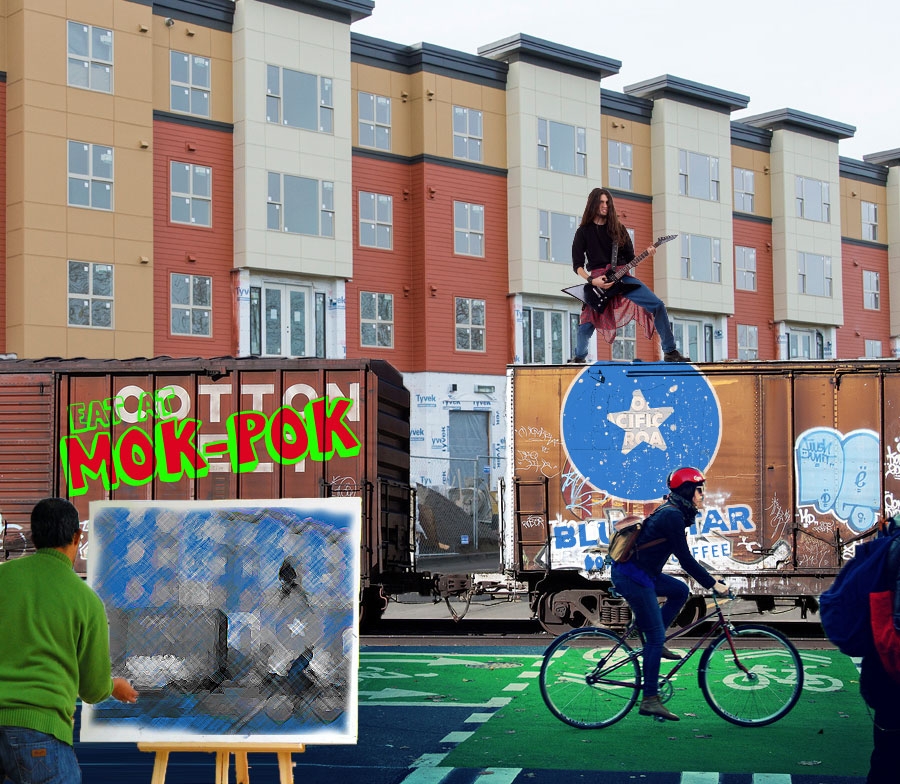The hollowing out of the American city is now a bona fide cultural meme. Newspapers, magazines and digital media sites are publishing story after story about the morphing of urban grit and diversity into bastions of wealth and commodity culture.
Among the many articles that have appeared in the Portland press are Willamette Week’s ode to the displaced artist and an article published yesterday in the Oregonian about skyrocketing rents in Hood River.
The national media sound similar themes. In his New York Times essay, My Dark California Dream, writer Daniel Duane profiled a “profound mood of loss: Oakland, long a bastion of African-American cultural life, has seen housing rental rates jump 20 percent this past year; San Francisco’s lesbian bars are closing, and the Castro gets less gay by the year.”
There’s no denying the fact that housing prices are now rendering cities unaffordable for all but a narrow segment of the population. But lamenting a lost golden age disregards an important part of the urban dynamic. If concentration of wealth is a big part of the death of the city story, so is nostalgia — and solipsism.
Urban critic Ada Calhoun captures this self-absorption in her own New York Times essay: “My City was Gone (Or Was It?)”:
“If you’re complaining about the East Village, or New York in general, being dead, I think it’s worth considering the possibility that, yes, it is over — for you. But for plenty of others, the city is as full of potential and magic as it was in 1977. Or 1964. Or 1992. Or whenever you last walked down the street and felt like it belonged only to you.”
“Who understands the soul of anyplace?” Calhoun asks. “Who deserves to be here? Who is the interloper and who the interloped-upon?”
In his review of the novel, City on Fire, a chronicle of New York in the 1970s, New Yorker writer Louis Menand makes a similar argument:
“New Yorkers today may complain about the gentrification and the commodification and the tourists. But not many of those people would have lasted long in the city of 1975. There were no espresso bars in the nineteen-seventies, no Mario Batali or David Chang or Dan Barber. There was Chock full o’ Nuts, and people ate in places like Lüchow’s and Mama Leone’s, huge barns of fat and cholesterol.”
One can make similar claims about Portland. In the ’80s and into the ’90s, affordable housing was ubiquitous. So was grunge, the kind of grittiness that seeped into novels like Geek Love and the movie Drugstore Cowboy.
But one man’s urban utopia is another man’s nightmare. Twenty years ago there were no bicycle and pedestrian bridges, no vegan bakeries, no Stumptown, no Pok Poks. On the contrary, many inner city neighborhoods were deemed undesirable by middle class residents — so much so that in 1997 many friends thought we were crazy to move into SE Portland’s Sunnyside neighborhood, considered too rundown for a young family to inhabit.
Cities are victims of their own success. We are, most of us, agents of change in a constantly evolving urban environment.
***
On a related note, I’m headed this weekend up to Seattle, where the city’s effort to upzone the entire city (rezone all single family neighborhoods for multifamily housing) as an affordable housing solution failed miserably over the summer. I asked Portland State University urban planning professor Ethan Seltzer his views on city-wide upzoning as means of boosting affordable housing stock.
He emailed a few thoughts:
“If you care about affordability and you care about gentrification, then you need to support building more units and creating many different kinds of units in every neighborhood. That is, it’s not so much about the zone you choose as it is about the basic principle that we need to be able to add units that don’t look like single-family detached houses in every neighborhood, rich, poor and in-between.”
But upzoning, like inclusionary zoning, is no panacea, Seltzer said.
“Changing from a lower density to higher density zone does not necessarily create a diversity of housing types. If our goal is a diversity of housing types/units in every neighborhood, then zoning may not be the best way to go. “
Seltzer said a better solution might be to revisit affordable housing overlay zones: incentives that encourage developers to build affordable housing.




